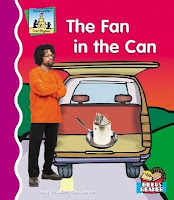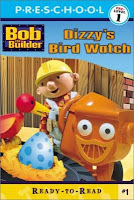Rebus Books
What are rebus books?
A rebus book, or picture reader, tells its story using a combination of text and small pictures or icons. The pictures represent characters or key elements in the story and are used throughout the book in place of the corresponding word/name. For example, in a story about a duck’s adventures, the word “duck” would always be replaced in sentences with the picture of a duck. Sometimes the word is written under the picture, and other times the picture stands alone, depending on the publisher. Here is an example:
Why use them?
Rebus books are generally made for beginning readers to assist with building reading skills. First, they can help younger children grasp the concept of reading - the squiggles on the page actually correspond to something! Second, they can help hold kids’ attention, since the pictures enable them to follow along with the story and “read” even if they do not yet know sight words. In our increasingly graphic-based society filled with apps, symbols, and logos, studies show that “digital natives” (those who grow up using computers, smartphones, etc.) look for graphics or visual representations first, then read the plain text. A child who sees a recognizable graphic in a sea of text may be more interested in finding out what the text is about than if they saw only text. Either way, when a child makes connections and starts following along with the story, it gives a sense of accomplishment, pride, and confidence… which encourages more and more reading!
Where can I find them?
Rebus books form a fairly small subset of the early reader genre, and they are one of an array of formats designed to encourage reading. While they may not match your child’s learning style, they just might be a hit! Here are some titles to try:
Max and Ruby's Show-and-Tell by Rosemary Wells (ER WEL)
Part of the All Aboard Reading Picture Reader series, this is a humorous story about bunny siblings Max and Ruby. Ruby makes a cake for show-and-tell at school and Max, after being told by Ruby that he cannot participate, decides to take matters into his own hands and “bake” a mud cake that he sneaks into Ruby’s classroom. This book has no text under the rebuses, but the objects are easy to identify. Also, there are flash cards at the back of the book to help match the pictures with their words.
The Fan in the Can by Mary Elizabeth Salzmann (ER SAL)
Part of the First Rhymes series, this title focuses on the “-an” word ending. It is fairly utilitarian, geared more to teaching reading than to telling a fascinating story, but it has a nice progression. First, it opens with a page labeling all the images used (can, fan, man, pan, and van). Next, it uses each in a sentence. Then, it presents each image with a short, descriptive sentence underneath. Finally, it ends with a mini story about a fan using a traditional storybook format: regular text-only sentences on one side of the page and pictures on the other.
Bob the Builder: Dizzy’s Bird Watch by Alison Inches (ER INC)
This is a good fit for any beginning readers who love Bob the Builder. It tells the story of Bob’s cement-mixer, Dizzy, who is tasked with protecting a bird’s egg until it hatches. Dizzy gets distracted, and disaster almost strikes… but all ends well. Each rebus used has the corresponding word printed under it (which is helpful if you do not know the Bob the Builder characters’ names!).
"I Can't," Said the Ant: A Second Book of Nonsense by Polly Cameron (E CAM)
Written in 1961, this cute, classic tale tells the story of a heroic ant who comes to the rescue of Miss Teapot when she falls to the floor and breaks her spout. The story is told in rhyme, and alternates between a regular book set-up when the narrator is talking (text on one page, picture on the other) and a rebus set-up when a character speaks (large-print sentences with graphics). For example,
“‘Teapot fell,’ [image of a bell] ‘said the dinner bell.’
‘Teapot broke,’ [image of an artichoke] said the artichoke.”
While not a traditional rebus, it uses the same basic principle of inserting images into text, and, unlike the First Rhymes series, its focus is on telling a good story.
Inside a Barn in the Country by Alyssa Satin Capucilli (E CAP)
The author of the Biscuit series plus the illustrator/author of the Fly Guy series equals a winning combo! This is a hybrid rebus book that alternates regular text with rebus text, similar to “I Can’t.” Said the Ant. One page spread will lay out the storyline in regular text, and the next will sum up the action and substitute the animal word for its picture. Starting with the mouse who squeaked, we meet 10 animals, one at a time, who are awakened by the escalating ruckus. Finally, the farmer tells them all to go back to sleep, and all ends on a happy note.
For more titles, try searching the library’s online catalog for the following terms:
Duck image courtesy of http: www.dailyclipart.net="".
Pond image from https://openclipart.org/detail/13141/reed.
A rebus book, or picture reader, tells its story using a combination of text and small pictures or icons. The pictures represent characters or key elements in the story and are used throughout the book in place of the corresponding word/name. For example, in a story about a duck’s adventures, the word “duck” would always be replaced in sentences with the picture of a duck. Sometimes the word is written under the picture, and other times the picture stands alone, depending on the publisher. Here is an example:
Why use them?
Rebus books are generally made for beginning readers to assist with building reading skills. First, they can help younger children grasp the concept of reading - the squiggles on the page actually correspond to something! Second, they can help hold kids’ attention, since the pictures enable them to follow along with the story and “read” even if they do not yet know sight words. In our increasingly graphic-based society filled with apps, symbols, and logos, studies show that “digital natives” (those who grow up using computers, smartphones, etc.) look for graphics or visual representations first, then read the plain text. A child who sees a recognizable graphic in a sea of text may be more interested in finding out what the text is about than if they saw only text. Either way, when a child makes connections and starts following along with the story, it gives a sense of accomplishment, pride, and confidence… which encourages more and more reading!
Where can I find them?
Rebus books form a fairly small subset of the early reader genre, and they are one of an array of formats designed to encourage reading. While they may not match your child’s learning style, they just might be a hit! Here are some titles to try:
Max and Ruby's Show-and-Tell by Rosemary Wells (ER WEL)
Part of the All Aboard Reading Picture Reader series, this is a humorous story about bunny siblings Max and Ruby. Ruby makes a cake for show-and-tell at school and Max, after being told by Ruby that he cannot participate, decides to take matters into his own hands and “bake” a mud cake that he sneaks into Ruby’s classroom. This book has no text under the rebuses, but the objects are easy to identify. Also, there are flash cards at the back of the book to help match the pictures with their words.
The Fan in the Can by Mary Elizabeth Salzmann (ER SAL)
Part of the First Rhymes series, this title focuses on the “-an” word ending. It is fairly utilitarian, geared more to teaching reading than to telling a fascinating story, but it has a nice progression. First, it opens with a page labeling all the images used (can, fan, man, pan, and van). Next, it uses each in a sentence. Then, it presents each image with a short, descriptive sentence underneath. Finally, it ends with a mini story about a fan using a traditional storybook format: regular text-only sentences on one side of the page and pictures on the other.
Bob the Builder: Dizzy’s Bird Watch by Alison Inches (ER INC)
This is a good fit for any beginning readers who love Bob the Builder. It tells the story of Bob’s cement-mixer, Dizzy, who is tasked with protecting a bird’s egg until it hatches. Dizzy gets distracted, and disaster almost strikes… but all ends well. Each rebus used has the corresponding word printed under it (which is helpful if you do not know the Bob the Builder characters’ names!).
"I Can't," Said the Ant: A Second Book of Nonsense by Polly Cameron (E CAM)
Written in 1961, this cute, classic tale tells the story of a heroic ant who comes to the rescue of Miss Teapot when she falls to the floor and breaks her spout. The story is told in rhyme, and alternates between a regular book set-up when the narrator is talking (text on one page, picture on the other) and a rebus set-up when a character speaks (large-print sentences with graphics). For example,
“‘Teapot fell,’ [image of a bell] ‘said the dinner bell.’
‘Teapot broke,’ [image of an artichoke] said the artichoke.”
While not a traditional rebus, it uses the same basic principle of inserting images into text, and, unlike the First Rhymes series, its focus is on telling a good story.
Inside a Barn in the Country by Alyssa Satin Capucilli (E CAP)
The author of the Biscuit series plus the illustrator/author of the Fly Guy series equals a winning combo! This is a hybrid rebus book that alternates regular text with rebus text, similar to “I Can’t.” Said the Ant. One page spread will lay out the storyline in regular text, and the next will sum up the action and substitute the animal word for its picture. Starting with the mouse who squeaked, we meet 10 animals, one at a time, who are awakened by the escalating ruckus. Finally, the farmer tells them all to go back to sleep, and all ends on a happy note.
For more titles, try searching the library’s online catalog for the following terms:
- Rebuses
- Rebuses—Juvenile fiction
- Rebuses—Juvenile literature
- Picture reader
-Jennifer Post, Lawrence HQ Branch
Duck image courtesy of http: www.dailyclipart.net="".
Pond image from https://openclipart.org/detail/13141/reed.






Comments
Post a Comment